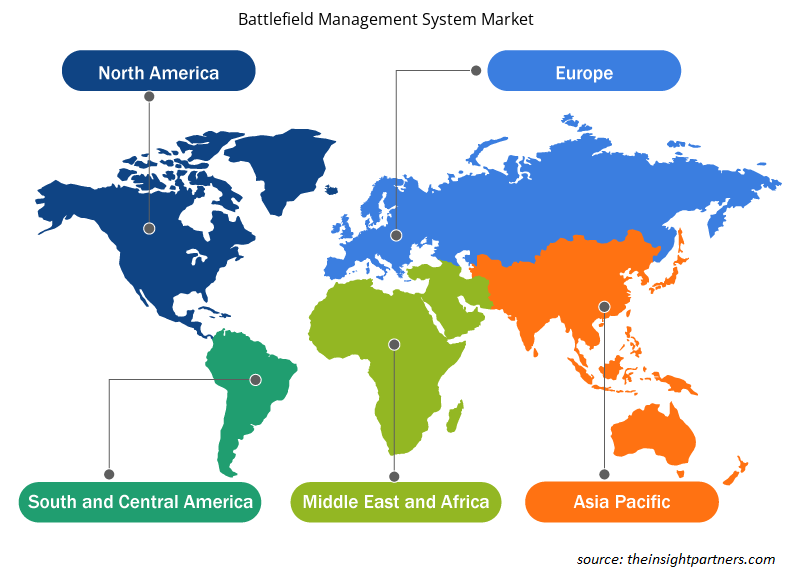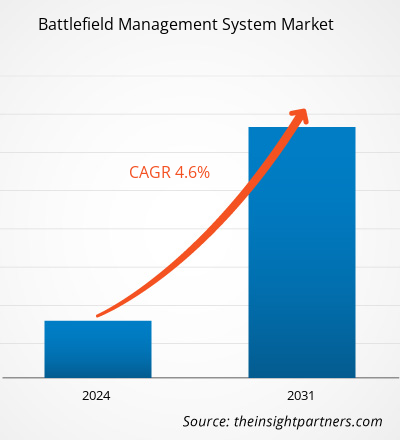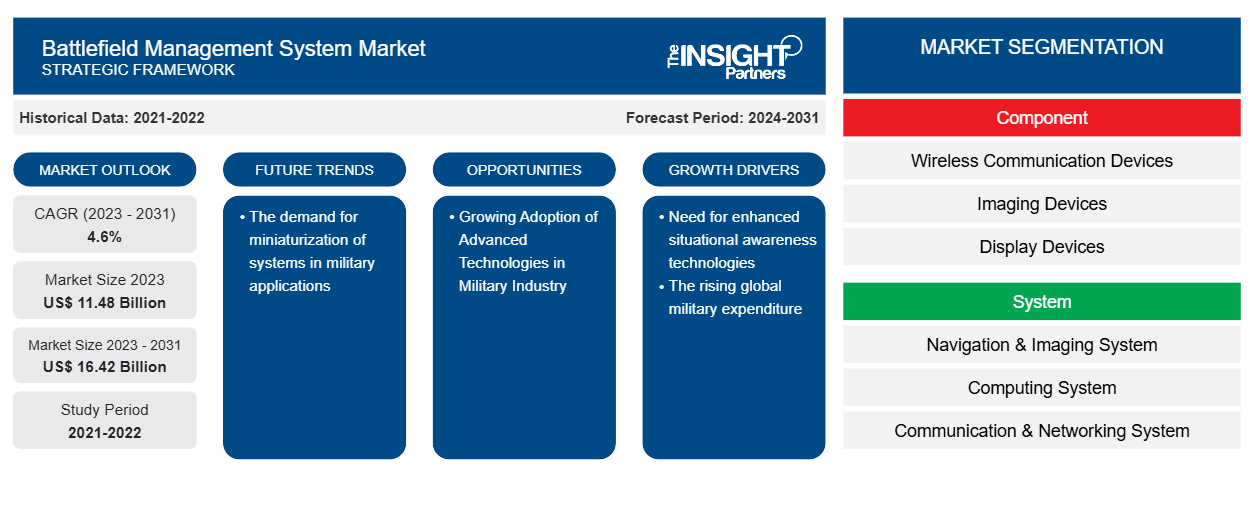Se prevé que el tamaño del mercado de sistemas de gestión del campo de batalla alcance los 16.420 millones de dólares en 2031, frente a los 11.480 millones de dólares en 2023. Se espera que el mercado registre una CAGR del 4,6 % durante el período 2023-2031. Es probable que la demanda de miniaturización de sistemas en aplicaciones militares siga siendo una tendencia clave en el mercado.
Análisis del mercado de sistemas de gestión de campos de batalla
El mercado abarca principalmente a desarrolladores de software, desarrolladores de sistemas, integradores de sistemas y usuarios finales. Los actores del mercado son principalmente desarrolladores de software como Atos, Systematic y Rolta, que ofrecen soluciones basadas en software para la gestión del campo de batalla gracias a su experiencia técnica. Los desarrolladores de sistemas son los fabricantes de hardware que son los precursores en este mercado, ya que obtienen contactos de diferentes fuerzas militares. Los desarrolladores de software y los desarrolladores de sistemas operan de manera sincronizada. Una vez que se desarrollan el sistema y el software, los desarrolladores de sistemas pasan las soluciones a los integradores de sistemas, quienes finalmente integran el software en el sistema, quienes luego entregan el BMS a las fuerzas armadas. Varios desarrolladores de sistemas también operan como integradores de sistemas y proporcionan el sistema completo a los usuarios finales directamente. Los usuarios finales comprenden varias fuerzas armadas en todo el mundo, lo que representa el lado de la demanda del mercado.
Descripción general del mercado de sistemas de gestión de campos de batalla
En la actualidad, el mercado de sistemas de gestión del campo de batalla está formado por grandes actores establecidos con una base de clientes sustancial. Además, las grandes barreras de entrada, junto con la inclinación del gobierno a recompensar los compromisos comerciales anteriores de larga duración, también han contribuido a la baja amenaza de nuevos participantes en el mercado de sistemas de gestión del campo de batalla. Sin embargo, se prevé que los recientes recortes presupuestarios, así como el aumento de la demanda de una planificación , gestión y operación logísticas superiores, alivien las barreras para determinadas ofertas logísticas. Por ejemplo, se espera que las oportunidades de mejorar los servicios relacionados con la logística, como la consultoría, la optimización y la integración y el soporte de tecnologías avanzadas junto con su soporte logístico, supongan barreras de entrada moderadas durante los próximos años.
Personalice este informe según sus necesidades
Obtendrá personalización en cualquier informe, sin cargo, incluidas partes de este informe o análisis a nivel de país, paquete de datos de Excel, así como también grandes ofertas y descuentos para empresas emergentes y universidades.
-
Obtenga las principales tendencias clave del mercado de este informe.Esta muestra GRATUITA incluirá análisis de datos, desde tendencias del mercado hasta estimaciones y pronósticos.
Factores impulsores y oportunidades del mercado de sistemas de gestión del campo de batalla
Necesidad de tecnologías de mayor conciencia situacional
La conciencia situacional o estar al tanto de la ubicación es primordial durante la batalla. El campo de batalla presenta varios desafíos para la conciencia situacional, lo que supone una amenaza sustancial para los soldados desmontados, así como para los vehículos. Esto se debe al hecho de que los enemigos o las fuerzas militantes están utilizando tecnologías avanzadas, lo que crea una situación desafiante para las fuerzas armadas durante la toma de decisiones. El objetivo principal del BMS es superar estos desafíos de manera eficiente ayudando a los soldados a pensar y actuar rápidamente. Se considera que el BMS aumenta la conciencia situacional, especialmente en situaciones en las que la trazabilidad del enemigo es baja. Ayuda a reconocer y comprender elementos críticos de información sobre la actividad del equipo, particularmente en un campo de batalla.
Creciente adopción de tecnologías avanzadas en la industria militar
El sector militar de todo el mundo se propone mejorar sus capacidades terrestres, aéreas y navales mediante diversos avances tecnológicos. El aumento de las actividades transfronterizas y las situaciones inevitables que se producen a través de las fronteras exigen sistemas técnicos avanzados. La inteligencia artificial (IA), cuando se integra con armas, drones y otros productos, desempeña un papel importante en el sector militar. La investigación sobre IA está en curso en los campos de recopilación y análisis de inteligencia, mando y control, y en una variedad de vehículos, y se ha incorporado a las operaciones militares en Siria e Irak. China apuesta por la IA para optimizar sus capacidades de defensa y se prevé que se convierta en el líder mundial en el campo de la IA para 2030. Actualmente, se centran en el uso de la IA para tomar decisiones bien informadas y más rápidas y en la construcción de una variedad de vehículos militares autónomos. Rusia también participa activamente en la integración de la IA para las tecnologías militares, con un enfoque significativo en la robótica. Es probable que estos factores proporcionen oportunidades futuras en los próximos años.
Análisis de segmentación del informe de mercado del sistema de gestión del campo de batalla
Los segmentos clave que contribuyeron a la derivación del análisis del mercado del sistema de gestión del campo de batalla son el componente, el sistema y la aplicación.
- Según los componentes, el mercado de sistemas de gestión del campo de batalla se segmenta en dispositivos de comunicación inalámbrica, dispositivos de imágenes, dispositivos de visualización, software informático y dispositivos de seguimiento. El segmento de dispositivos de comunicación inalámbrica tuvo una mayor participación de mercado en 2023.
- Según el sistema, el mercado de sistemas de gestión del campo de batalla se segmenta en sistemas de navegación e imágenes, sistemas informáticos y sistemas de comunicación y redes. El segmento de sistemas de comunicación y redes tuvo una mayor participación de mercado en 2023.
- Según la aplicación, el mercado de sistemas de gestión del campo de batalla se segmenta en vehículos, soldados y cuarteles generales. El segmento de cuarteles generales tuvo una mayor participación de mercado en 2023.
Análisis de la cuota de mercado del sistema de gestión del campo de batalla por geografía
El alcance geográfico del informe de mercado del sistema de gestión del campo de batalla se divide principalmente en cinco regiones: América del Norte, Europa, Asia Pacífico, Medio Oriente y África, y América del Sur.
América del Norte ha dominado el mercado en 2023, seguida de las regiones de Europa y Asia Pacífico. Además, es probable que Asia Pacífico también sea testigo de la CAGR más alta en los próximos años. Estados Unidos dominó el mercado de sistemas de gestión del campo de batalla de América del Norte en 2023. Esto se debe a la presencia del país con mayor gasto militar, es decir, Estados Unidos, que también comprende algunos de los principales actores que operan en el mercado de sistemas de gestión del campo de batalla. Algunos de los principales actores que tienen presencia en el mercado de sistemas de gestión del campo de batalla de América del Norte incluyen proveedores como BAE Systems Plc, General Dynamics Corporation, Raytheon Technologies Corporation, L3Harris Technologies Inc, Lockheed Martin Corporation y Northrop Grumman Corporation.
Alcance del informe de mercado del sistema de gestión del campo de batalla
Perspectivas regionales del mercado de sistemas de gestión del campo de batalla
Los analistas de Insight Partners explicaron en detalle las tendencias y los factores regionales que influyen en el mercado de sistemas de gestión del campo de batalla durante el período de pronóstico. Esta sección también analiza los segmentos y la geografía del mercado de sistemas de gestión del campo de batalla en América del Norte, Europa, Asia Pacífico, Oriente Medio y África, y América del Sur y Central.

- Obtenga datos regionales específicos para el mercado de sistemas de gestión del campo de batalla
Alcance del informe de mercado del sistema de gestión del campo de batalla
| Atributo del informe | Detalles |
|---|---|
| Tamaño del mercado en 2023 | US$ 11,48 mil millones |
| Tamaño del mercado en 2031 | US$ 16,42 mil millones |
| CAGR global (2023 - 2031) | 4,6% |
| Datos históricos | 2021-2022 |
| Período de pronóstico | 2024-2031 |
| Segmentos cubiertos |
Por componente
|
| Regiones y países cubiertos |
América del norte
|
| Líderes del mercado y perfiles de empresas clave |
|
Densidad de actores del mercado de sistemas de gestión del campo de batalla: comprensión de su impacto en la dinámica empresarial
El mercado de sistemas de gestión de campos de batalla está creciendo rápidamente, impulsado por la creciente demanda de los usuarios finales debido a factores como la evolución de las preferencias de los consumidores, los avances tecnológicos y una mayor conciencia de los beneficios del producto. A medida que aumenta la demanda, las empresas amplían sus ofertas, innovan para satisfacer las necesidades de los consumidores y aprovechan las tendencias emergentes, lo que impulsa aún más el crecimiento del mercado.
La densidad de actores del mercado se refiere a la distribución de las empresas o firmas que operan dentro de un mercado o industria en particular. Indica cuántos competidores (actores del mercado) están presentes en un espacio de mercado determinado en relación con su tamaño o valor total de mercado.
Las principales empresas que operan en el mercado de sistemas de gestión del campo de batalla son:
- BAE Systems Plc
- Elbit Systems Ltd
- Corporación General Dynamics
- L3Harris Technologies Inc
- Leonardo SpA
- Corporación Raytheon Technologies
Descargo de responsabilidad : Las empresas enumeradas anteriormente no están clasificadas en ningún orden particular.

- Obtenga una descripción general de los principales actores clave del mercado de sistemas de gestión del campo de batalla
Noticias del mercado y desarrollos recientes del sistema de gestión del campo de batalla
El mercado de sistemas de gestión de campos de batalla se evalúa mediante la recopilación de datos cualitativos y cuantitativos a partir de una investigación primaria y secundaria, que incluye importantes publicaciones corporativas, datos de asociaciones y bases de datos. A continuación, se enumeran algunos de los avances en el mercado de sistemas de gestión de campos de batalla:
- Lockheed Martin Australia firmó un contrato histórico de 500 millones de dólares australianos con el Departamento de Defensa para construir el futuro Sistema Conjunto de Gestión de Batalla Aérea de Australia en el marco del proyecto AIR6500 Fase 1 (AIR6500-1). Este sistema proporcionará a Defensa una capacidad avanzada integrada de defensa aérea y de misiles, utilizando tecnologías de última generación, para combatir amenazas de alta velocidad. (Fuente: Lockheed Martin Corporation, comunicado de prensa, abril de 2024)
- El Ministerio de Defensa ha adjudicado a BAE Systems un contrato de 89 millones de libras esterlinas para mejorar la conectividad de primera línea para el personal militar, conectando pequeños drones de reconocimiento, vehículos de combate, aviones de combate, portaaviones y comandos militares. (Fuente: BAE Systems Plc, comunicado de prensa, agosto de 2023)
Informe de mercado sobre sistemas de gestión de campos de batalla: cobertura y resultados
El informe “Tamaño y pronóstico del mercado del sistema de gestión del campo de batalla (2021-2031)” proporciona un análisis detallado del mercado que cubre las siguientes áreas:
- Tamaño del mercado del sistema de gestión del campo de batalla y pronóstico a nivel global, regional y nacional para todos los segmentos clave del mercado cubiertos bajo el alcance
- Tendencias del mercado del sistema de gestión del campo de batalla, así como dinámicas del mercado, como impulsores, restricciones y oportunidades clave
- Análisis detallado de las cinco fuerzas de Porter
- Análisis del mercado de sistemas de gestión de campos de batalla que abarca las tendencias clave del mercado, el marco global y regional, los principales actores, las regulaciones y los desarrollos recientes del mercado
- Análisis del panorama de la industria y de la competencia que abarca la concentración del mercado, el análisis de mapas de calor, los actores destacados y los desarrollos recientes para el mercado de sistemas de gestión del campo de batalla
- Perfiles detallados de empresas
- Análisis histórico (2 años), año base, pronóstico (7 años) con CAGR
- Análisis PEST y FODA
- Tamaño del mercado, valor/volumen: global, regional y nacional
- Industria y panorama competitivo
- Conjunto de datos de Excel
Informes recientes
Informes relacionados
Testimonios
Razón para comprar
- Toma de decisiones informada
- Comprensión de la dinámica del mercado
- Análisis competitivo
- Información sobre clientes
- Pronósticos del mercado
- Mitigación de riesgos
- Planificación estratégica
- Justificación de la inversión
- Identificación de mercados emergentes
- Mejora de las estrategias de marketing
- Impulso de la eficiencia operativa
- Alineación con las tendencias regulatorias























 Obtenga una muestra gratuita para - Mercado de sistemas de gestión de campos de batalla
Obtenga una muestra gratuita para - Mercado de sistemas de gestión de campos de batalla